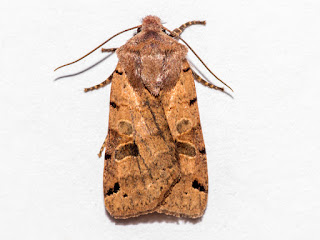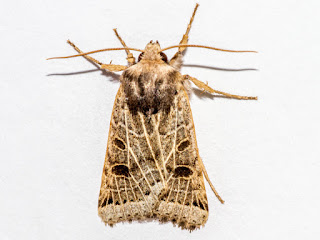Eyed Hawk-moth, North Elmham, 3rd September
There was also a Hornet and the following caddisflies: Hydropsyche pellucidula, Hydropsyche siltalai, Limnephilus auricula and 7 Limnephilus lunatus.
Moth trapping at the meadows the following night produced a reasonable variety for this late in the season: Brown Rowan Argent Argyresthia semifusca, White-shouldered Smudge Ypsolopha parenthesella, 2 Common Marbles Celypha lacunana, Bramble Shoot Notocelia uddmanniana, Water Veneer Acentria ephemerella, 2 Ringed China-marks Parapoynx stratiotata, 2 Chinese Characters, Blood-vein, Dark-barred Twin-spot Carpet, Common Carpet, Yellow Shell, Sharp-angled Carpet, 3 Brimstone Moths, Dusky Thorn, Common Wave, Light Emerald, 4 Flame Shoulders, 3 Large Yellow Underwings, Lesser Yellow Underwing, Broad-bordered Yellow Underwing, 2 Lesser Broad-bordered Yellow Underwings, 2 Setaceous Hebrew Characters, 35 Square-spot Rustics, White-point, Brown-spot Pinion, 4 Centre-barred Sallows, Vine's Rustic, Spectacle, Straw Dot and 2 Snouts.
White-point, North Elmham Cathedral Meadows, 4th September
Brown-spot Pinion, North Elmham Cathedral Meadows, 4th September
Just one mayfly noticed, a Blue-winged Olive Serratella ignita. A good variety of caddisflies though: Polycentropus flavomaculatus, Hydropsyche pellucidula, 2 Small Silver Sedges Lepidostoma hirtum, Mottled Sedge Glyphotaelius pellucidus, 3 Limnephilus auricula, 30 Limnephilus lunatus, Limnephilus marmoratus and Limnephilus sparsus.
Leafhoppers included a probable female Macrosteles sexnotatus and a new species for me, Aphrodes makarovi.
Aphrodes makarovi, North Elmham Cathedral Meadows, 4th September
Beetles included Strawberry Seed Beetle Harpalus rufipes, Pea-leaf Weevil Sitona lineatus and, feeding on Burdock flowers, Curtonotus aulicus.
Curtonotus aulicus, North Elmham Cathedral Meadows, 4th September
At home that night Pine Carpet was new for the year. Other highlights were Beech Pigmy Stigmella hemargyrella and Thatch Neb Bryotropha basaltinella. The former was my third this year of a species I hadn't previously recorded here and the latter was my fourth this year of a species that until this year hadn't been recorded anywhere else in Norfolk.
Beech Pigmy Stigmella hemargyrella (male, gen det), North Elmham, 4th September
Thatch Neb Bryotropha basaltinella (male, gen det), North Elmham, 4th September
By recent standards 32 species in a night was excellent - the rest were Garden Midget Phyllonorycter messaniella, Beech Midget Phyllonorycter maestingella, Clover Case-bearer Coleophora alcyonipennella, 2 Little Dwarfs Elachista canapennella, Barred Fruit-tree Tortrix Pandemis cerasana, Light Brown Apple-moth Epiphyas postvittana, 7 Common Marbles Celypha lacunana, 4 Common Grass-veneers Agriphila tristella, 6 Elbow-stripe Grass-veneers Agriphila geniculea, Chequered Grass-veneer Catoptria falsella, 2 Ringed China-marks Parapoynx stratiotata, Common Plume Emmelina monodactyla, 4 Blood-veins, Grey Pine Carpet, Green Carpet, 5 Brimstone Moths, Dusky Thorn, 3 Light Emeralds, 13 Large Yellow Underwings, 2 Lesser Yellow Underwings, Setaceous Hebrew Character, 4 Square-spot Rustics, Nutmeg, Angle Shades, Flounced Rustic, 4 Vine's Rustics, Burnished Brass, Straw Dot and 4 Snouts.
Mayflies and lacewings were 3 Pond Olives Cloeon dipterum, Cunctochrysa albolineata and Hemerobius humulinus.
There were very large numbers of caddisflies in the trap, though no unusual species among them: 10 Hydropsyche pellucidula, 3 Mottled Sedges Glyphotaelius pellucidus, 13 Limnephilus auricula, 3 Limnephilus flavicornis, 46 Limnephilus lunatus, 2 Limnephilus marmoratus and 3 Limnephilus sparsus.
Not much else noted - Forest Bug, the sexton beetle Nicrophorus investigator, 5 Hornets and a Common Frog.
The following night the leafhopper Kybos betulicola appeared in my study
In the moth trap there were two new moths for the garden year-list, Brown-spot Pinion and Lunar Underwing.
Brown-spot Pinion, North Elmham, 5th September
Lunar Underwing, North Elmham, 5th September
Other moths were Dark-triangle Button Acleris laterana, Garden Rose Tortrix Acleris variegana, Barred Marble Celypha striana, 3 Common Marbles Celypha lacunana, Grey Poplar Bell Epinotia nisella, 4 Elbow-stripe Grass-veneers Agriphila geniculea, Garden Carpet, 2 Brimstone Moths, Dusky Thorn, Engrailed, Light Emerald, Flame Shoulder, 6 Large Yellow Underwings, 5 Lesser Yellow Underwings, Setaceous Hebrew Character, 2 Square-spot Rustics, Common Wainscot, Frosted Orange, Vine's Rustic and 3 Snouts.
Other insects included the mayfly Blue-winged Olive Serratella ignita, the brown lacewing Hemerobius lutescens, the caddisflies 3 Hydropsyche pellucidula, Mottled Sedge Glyphotaelius pellucidus, 4 Limnephilus auricula, 3 Limnephilus flavicornis, 16 Limnephilus lunatus, 3 Limnephilus marmoratus and 2 Limnephilus sparsus, a Harlequin Ladybird and 2 Hornets.
Moth numbers continued to dwindle with the following on 6th: Garden Rose Tortrix Acleris variegana, Barred Marble Celypha striana, Common Marble Celypha lacunana, 2 Elbow-stripe Grass-veneers Agriphila geniculea, Ringed China-mark Parapoynx stratiotata, Single-dotted Wave, Brimstone Moth, 5 Large Yellow Underwings, 5 Lesser Yellow Underwings and Setaceous Hebrew Character. There was one mayfly (Pond Olive Cloeon dipterum), one beetle (Bradycellus verbasci) and these caddisflies: Hydropsyche pellucidula, Mottled Sedge Glyphotaelius pellucidus, Limnephilus flavicornis, 6 Limnephilus lunatus and Limnephilus sparsus.
Next day a walk round the meadows produced a few insects including Migrant Hawker, Common Darter, Small Copper and Comma.
Small Copper, North Elmham Cathedral Meadows, 7th September
A White-shouldered Smudge Ypsolopha parenthesella was the only adult moth found but vacated leaf-mines of Scrubland Pigmy Stigmella plagicolella and 2 Apple Leaf-miners Lyonetia clerkella were also seen.
vacated leaf-mine of Scrubland Pigmy Stigmella plagicolella in Blackthorn, North Elmham Cathedral Meadows, 7th September
vacated leaf-mines of Apple Leaf-miners Lyonetia clerkella in Wild Cherry, North Elmham Cathedral Meadows, 7th September
Other insects included 2 7-spot Ladybirds, the hoverfly Myathropa florea, a Turnip Sawfly and lots of wasps feeding on ivy. They included lots of Common Wasps, at least one German Wasp and 2 Hornets, but among them I had brief views of a Colletes bee which was very probably an Ivy Bee. Ivy Bee was new to science as recently as 1993 and arrived in the UK in 2001, reaching Norfolk by 2014. It is now common in many places but as hard as I tried to find one at the meadows this autumn this brief sighting was the nearest I got. Sadly it wasn't quite good enough to be 100% sure - I believe there are one or two other Colletes species that can visit ivy at this time of year and my views were not sufficient to rule out one of them.
Turnip Sawfly, North Elmham Cathedral Meadows, 7th September
Shaking some Field Maple keys produced the barkfly Ectopsocus briggsi, a harvestman and 2 spiders. The latter were I think immature, or at least I could not see enough detail in their epigyne to be able to match them to any species, but I think they were an Araniella sp. and a Philodromus sp. My references on harvestmen are sparse but from searching the internet I'm pretty sure this one was Paroligolophus agrestis, a species I hadn't previously identified.
Ectopsocus briggsi (female), North Elmham Cathedral Meadows, 7th September
Philodromus sp., North Elmham Cathedral Meadows, 7th September
Paroligolophus agrestis, North Elmham Cathedral Meadows, 7th September
At home that night a small selection of moths consisted of Garden Rose Tortrix Acleris variegana, Blood-vein, Double-striped Pug, Lilac Beauty, Early Thorn, Light Emerald, Heart and Dart, Flame Shoulder, Large Yellow Underwing, 6 Lesser Yellow Underwings, Square-spot Rustic and 2 Common Wainscots. There were 2 Hornets and the only other insects noted were caddisflies: 2 Mottled Sedges Glyphotaelius pellucidus, 10 Limnephilus lunatus and 2 Limnephilus marmoratus.
2 Sallows were new for the year the following night.
Sallow, North Elmham, 8th September
Other moths were 2 Beech Midgets Phyllonorycter maestingella, Brown Rowan Argent Argyresthia semifusca, 2 Light Brown Apple-moths Epiphyas postvittana, Rhomboid Tortrix Acleris rhombana, 3 Garden Rose Tortrixes Acleris variegana, Barred Marble Celypha striana, 9 Common Marbles Celypha lacunana, Small Birch Bell Epinotia ramella, Common Grass-veneer Agriphila tristella, Elbow-stripe Grass-veneer Agriphila geniculea, Chinese Character, Maiden's Blush, Blood-vein, 2 Garden Carpets, Treble-bar, 2 Brimstone Moths, 2 Dusky Thorns, Early Thorn, 2 Light Emeralds, Flame, Flame Shoulder, 2 Large Yellow Underwings, 5 Lesser Yellow Underwings, 2 Square-spot Rustics, 2 Common Wainscots, Brown-spot Pinion, Lunar Underwing and Snout.
Other insects included 3 mayflies, all Pond Olives Cloeon dipterum, 2 green lacewings, both Cunctochrysa albolineata, 4 Forest Bugs and 2 beeetles, both Aphodius rufipes. Caddisflies were Hydropsyche siltalai, 5 Limnephilus auricula, Limnephilus flavicornis, 15 Limnephilus lunatus, Limnephilus marmoratus and Limnephilus sparsus.






















No comments:
Post a Comment